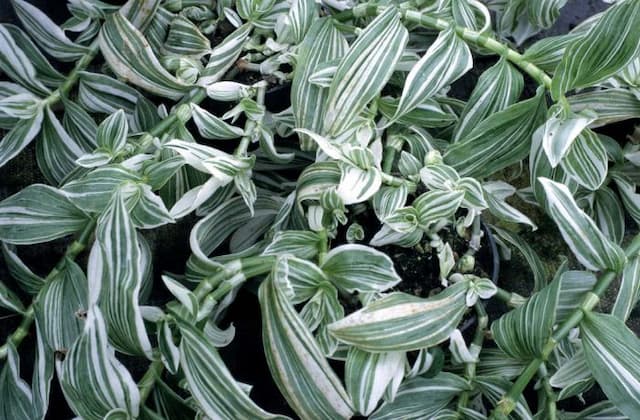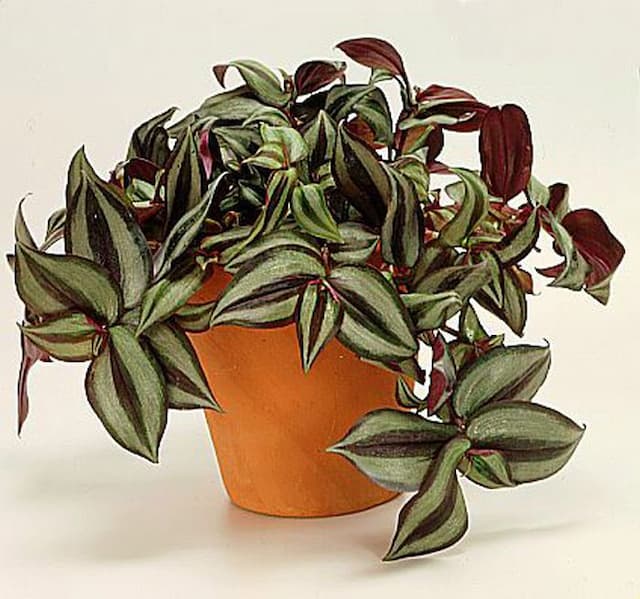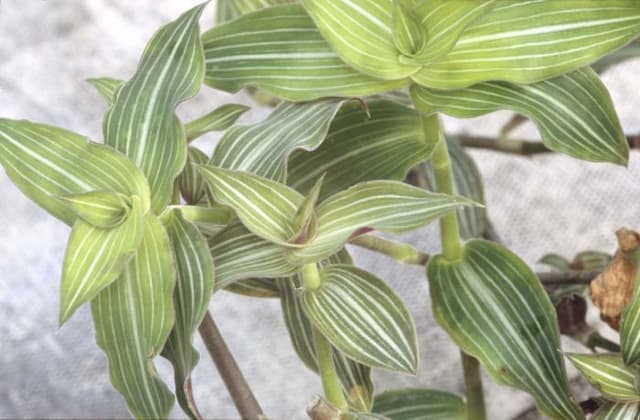Spiderwort Tradescantia (Andersoniana Group) 'Osprey'

ABOUT
The 'Osprey' variety from the Tradescantia group showcases a graceful formation of green foliage and distinctive flowers. The leaves are long and slender, forming a lush clump with a soft, almost grass-like appearance. Emanating from the foliage, the stems rise to support the blooms without referring to their specific lengths. The flowers are a captivating display of triple-petaled beauty, predominantly colored in a pristine white, providing a stark and attractive contrast against the green leaves. Each petal may occasionally exhibit a faint bluish-purple blush, adding subtle hints of color. At the center of the blossoms, there is a cluster of golden yellow stamens, which attracts pollinators and adds to the visual charm of the plant. These charming blooms have a characteristic triangular shape common to the Tradescantia family, and they appear in clusters that enhance the overall ornamental appeal of the plant. The 'Osprey' presents its flowers predominantly in the warmer months, providing a long season of interest throughout its blooming period. Overall, this plant's presence can be quite striking with its contrasting foliage and radiant blooms.
About this plant
 Names
NamesFamily
Commelinaceae.
Synonyms
Spiderwort, Widow's Tears.
Common names
Tradescantia (Andersoniana Group) 'Osprey'.
 Toxicity
ToxicityTo humans
The Spiderwort 'Osprey', is not known to be toxic to humans. However, as with many plants, it may cause a mild irritation to sensitive individuals. Ingesting any part of the plant is typically not associated with serious poisoning. In rare cases, ingestion can cause minor symptoms such as upset stomach, nausea, vomiting, or diarrhea. It is always advisable to keep non-food plants out of reach of children who might accidentally ingest them.
To pets
The Spiderwort 'Osprey', is not known to be highly toxic to pets, such as cats and dogs. Although it is not considered toxic, it may still cause mild gastrointestinal upset if ingested in large quantities. Signs that your pet may have eaten part of the plant include vomiting, diarrhea, or drooling. These symptoms are often self-limiting, but if your pet exhibits persistent or severe symptoms, it is advisable to consult a veterinarian.
 Characteristics
CharacteristicsLife cycle
Perennials
Foliage type
Deciduous
Color of leaves
Green
Flower color
White
Height
1-2 feet (30-60 cm)
Spread
1-1.5 feet (30-45 cm)
Plant type
Herb
Hardiness zones
4-9
Native area
North America
Benefits
 General Benefits
General Benefits- Easy to Grow: Tradescantia 'Osprey' is known for being low-maintenance and easy to care for, making it suitable for novice gardeners.
- Drought Tolerant: Once established, this plant is quite tolerant of drought, reducing the need for frequent watering.
- Rapid Growth: It grows quickly, providing a lush appearance in garden spaces or interior settings in a relatively short time span.
- Ground Cover: Its spreading habit makes it an excellent ground cover, filling in large areas and suppressing weeds.
- Ornamental Appeal: With attractive white and purple flowers, and variegated foliage, 'Osprey' provides aesthetic value to gardens.
- Pollinator Friendly: The flowers attract bees, butterflies, and other pollinators, supporting local ecosystems.
- Versatility: This plant can thrive in various conditions, including hanging baskets, containers, and as a border plant in gardens.
- Seasonal Interest: It offers seasonal interest with blossoms appearing mainly during the warmer months and foliage providing visual appeal year-round in milder climates.
 Medical Properties
Medical PropertiesThis plant is not used for medical purposes.
 Air-purifying Qualities
Air-purifying QualitiesThis plant is not specifically known for air purifying qualities.
 Other Uses
Other Uses- Photography Backdrop: Tradescantia 'Osprey's' striking white and lavender flowers can act as a beautiful natural backdrop for macro or nature photography.
- Educational Tool: Can be used to teach students about plant propagation, as Tradescantia spp. are easily propagated from stem cuttings.
- Artistic Inspiration: Artists may use the varied hues of the Tradescantia 'Osprey's' foliage and flowers as inspiration for color palettes in paintings and textile designs.
- Space Filler in Landscaping: Its spreading habit makes it ideal for filling gaps in garden beds or covering unsightly bare spots in the landscape.
- Ground Cover for Wildlife Habitat: Provides cover for small wildlife when used as a dense ground cover in gardens and natural areas.
- Natural Dye: The pigments in Tradescantia 'Osprey' may be used to create natural dyes for fabrics, yarns, or paper.
- Floral Arrangements: Fresh or dried, can be utilized in floral arrangements for its attractive flowers and foliage.
- Garden Borders: With its compact growth, it can define the edges of garden paths and borders.
- Livestock Forage: Although not commonly used, can potentially be a forage plant for some livestock if other forage options are limited.
- Companion Planting: Can be used in companion planting to fill understory areas and offer contrast to taller companion plants.
Interesting Facts
 Feng Shui
Feng ShuiThe Spiderwort is not used in Feng Shui practice.
 Zodiac Sign Compitability
Zodiac Sign CompitabilityThe Spiderwort is not used in astrology practice.
 Plant Symbolism
Plant Symbolism- Adaptability: Tradescantia, commonly known as Spiderwort, often symbolizes adaptability because it is a hardy plant that can thrive in a variety of conditions.
- Transience: Spiderwort flowers tend to open in the morning and fade by afternoon, which reflects the fleeting nature of life and beauty.
- Survival: With its ability to bounce back and survive in challenging environments, Spiderwort represents resilience and perseverance.
 Water
WaterSpiderwort 'Osprey' should be watered regularly, especially during the growing season in spring and summer, to keep the soil evenly moist but not waterlogged. Generally, providing about 1 inch of water per week is sufficient. During the hotter months, you may need to water more frequently to maintain moisture levels, while in the cooler months, water less often. Make sure to pour water directly onto the soil and not over the foliage to avoid leaf diseases. Adjust your watering routine based on rainfall, and always check the soil moisture before watering to prevent overwatering.
 Light
LightSpiderwort 'Osprey' thrives best in full sun to part shade conditions. An ideal spot would be where the plant receives morning sunlight and partial shade during the intense heat of the afternoon. They can tolerate full sun as well, but in particularly hot climates, some afternoon shade will help protect the plant from scorching.
 Temperature
TemperatureSpiderwort 'Osprey' prefers temperatures between 50°F and 90°F for optimal growth. They can survive brief periods of colder weather down to about 20°F, but should be protected from frost. The ideal temperature range ensures vibrant foliage and bountiful blooms, while temperatures above or below can impede its performance.
 Pruning
PruningPrune Spiderwort 'Osprey' to remove old flower stems and to encourage bushier growth and more blooms. Pruning can be done periodically throughout the growing season, especially after a flush of blooming has ended. Cutting back the foliage in late summer encourages fresh growth and can lead to a new bloom cycle in the fall.
 Cleaning
CleaningAs needed
 Soil
SoilThe Spiderwort 'Osprey' prefers a soil mix that is well-draining, rich in organic matter, and retains moisture without becoming waterlogged. A blend of peat, perlite, and pine bark would be ideal. Maintain soil pH between 6.0 and 6.5 for optimal growth.
 Repotting
RepottingSpiderwort 'Osprey' should be repotted every 2 to 3 years or when it outgrows its current container. Choose a pot that is one size larger than the current one to give the roots plenty of room to grow.
 Humidity & Misting
Humidity & MistingSpiderwort 'Osprey' fares best in moderate to high humidity conditions, ideally between 40% and 60%. If the air is too dry, the leaves can lose their vibrant color and become brown at the tips.
 Suitable locations
Suitable locationsIndoor
Place Spiderwort 'Osprey' in bright, indirect light indoors; water regularly.
Outdoor
Grow Spiderwort 'Osprey' in partial shade outdoors; protect from strong afternoon sun.
Hardiness zone
4-9 USDA
 Life cycle
Life cycleThe Tradescantia 'Osprey', also known as the Spiderwort 'Osprey', begins its life as a seed that germinates in moist, well-draining soil under partial to full sunlight. It progresses to a seedling stage, where the first true leaves and root system develop. As it enters the vegetative stage, the plant forms clumps of grass-like foliage and continues to grow thanks to photosynthesis. It then reaches the flowering stage, usually in late spring to summer, where it produces clusters of white flowers with contrasting purple stamens. After pollination, typically by insects, it sets seeds that are dispersed to start a new generation. Finally, in the fall or as temperatures drop, it enters a period of dormancy, with growth slowing down or halting until the following spring, completing its annual cycle.
 Propogation
PropogationPropogation time
Spring-Early Summer
Propogation: For the Spiderwort 'Osprey', the most popular method of propagation is by division. This is typically done in the spring or early fall to allow for establishing before the extremes of summer heat or winter cold. To propagate by division, gently dig up the entire clump of the plant and carefully separate it into smaller sections, ensuring each section has a portion of the root system. You can use your hands or a sharp knife to make the divisions. After dividing, immediately plant the sections at the same depth they were growing at before and water them thoroughly. This process allows the gardener to quickly multiply their Spiderwort 'Osprey' while also rejuvenating older plants that may have become too large or crowded.



